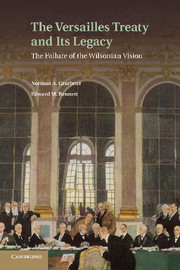Book contents
- Frontmatter
- Contents
- Preface
- 1 The International Order on Trial
- 2 The Road to Paris: 1917???1918
- 3 Versailles: A Study in Arrogance
- 4 The Retreat to Utopia
- 5 Manchuria and the Triumph of Non-Recognition
- 6 The Rise of Hitler
- 7 Challenge of the Dictators
- 8 The Elusive Response
- 9 Munich: The Continuing Escape from Reality
- 10 The Road to Prague
- 11 The Soviet Quest for Collective Security
- 12 The Coming of War: 1939
- Bibliography
- Index
- References
6 - The Rise of Hitler
Published online by Cambridge University Press: 07 October 2011
- Frontmatter
- Contents
- Preface
- 1 The International Order on Trial
- 2 The Road to Paris: 1917???1918
- 3 Versailles: A Study in Arrogance
- 4 The Retreat to Utopia
- 5 Manchuria and the Triumph of Non-Recognition
- 6 The Rise of Hitler
- 7 Challenge of the Dictators
- 8 The Elusive Response
- 9 Munich: The Continuing Escape from Reality
- 10 The Road to Prague
- 11 The Soviet Quest for Collective Security
- 12 The Coming of War: 1939
- Bibliography
- Index
- References
Summary
I
It is easy to judge the Versailles Treaty a failure. Within a decade, many of its key provisions faced inescapable assault. States carrying the responsibility for formulating a treaty become the automatic defenders of its provisions; certainly the victims of either diplomatic or military defeat would not defend it. Historian Arthur Link, in his defense of Woodrow Wilson, argued that World War II was primarily the result of the Depression. But the Depression, whatever its magnitude, could not set the world on the road to war unless the conditions for conflict were already well established. Three of the world’s major powers – Germany, Japan, and the USSR – believed themselves sufficiently victimized by the Versailles Treaty to tear it to shreds at the first opportunity. Only the Soviet Union deviated from this perspective for a time in its drive for collective security in the 1930s.
- Type
- Chapter
- Information
- The Versailles Treaty and its LegacyThe Failure of the Wilsonian Vision, pp. 107 - 123Publisher: Cambridge University PressPrint publication year: 2011



